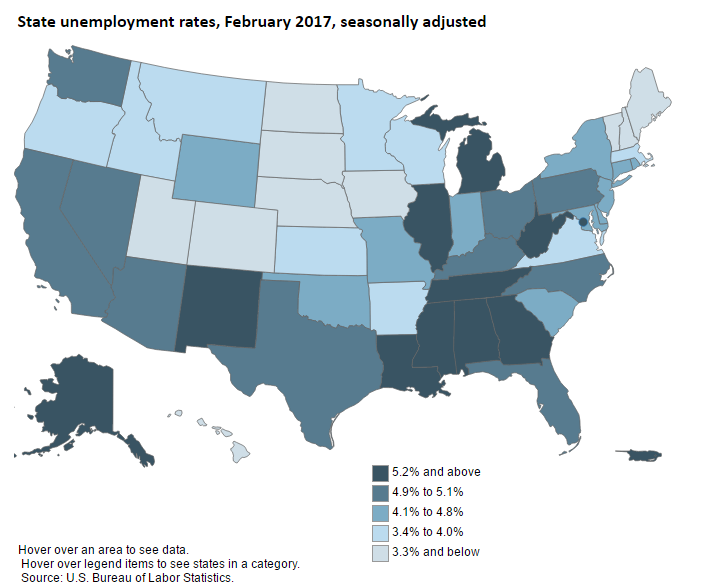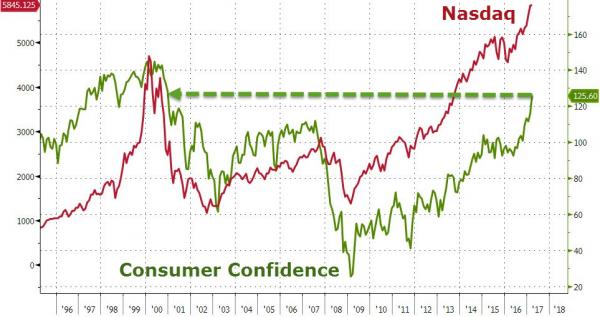Unlike former President Barack Obama, who was vested with the unenviable responsibility of shepherding a floundering economy post the Great Recession of 2008, President Donald Trump has inherited a fairly buoyant economy. Almost all vehicles of growth are alive and kicking. Consumer spending is running at fairly robust pace, thanks to a strong job market and abounding consumer confidence.
Soaring Consumer Confidence — Job Market Doing The Trick
Data released by the Conference Board Tuesday showed that consumer confidence improved sharply in March, with the index rising to 125.6, the best level since December 2000. The improvement was solidly supported by the perception concerning the job market. Those saying jobs are plentiful improved to its highest level since September 2001.
February NFP Report Vouches For Labor Market Strength
The key monthly non-farm payrolls report for February released on March 10 showed that the economy added 235,000 jobs, exceeding expectations for a 190,000-expansion. The jobless rate ticked down 0.1 percentage points to 4.7 percent.
Source: BLS
As seen from the chart, the jobless rate has been on a secular decline since 2010 after peaking at 10 percent in late 2009 amid the recession. The metric hit a post-recession low of 4.6 percent in November 2016 and has been holding near those levels since then.
Data Show Disparity
A look at whether the improvement has been broad based has returned a negative response. Based on February 2017 data, the unemployment rate has ranged between 6.8 percent in New Mexico and 2.7 percent in Hampshire.
These are the six states that have had the highest unemployment rate, with the metric running at a run rate higher than the national average.
- New Mexico — 6.8 percent.
- Alaska — 6.4 percent.
- Alabama — 6.2 percent.
- Louisiana — 5.8 percent.
- District of Columbia — 5.7 percent.
- Illinois — 5.4 percent.
 Source: U.S. Bureau of Labor Statistics
Source: U.S. Bureau of Labor Statistics
Benzinga looked at why these states have lagged behind and these are the findings.
Political Affiliation — Mixed
The political affiliation of electorates in these states were mixed in the 2016 presidential elections. New Mexico, Illinois and the District of Columbia voted for Democratic party candidate Hillary Clinton, while Alaska, Alabama and Louisiana backed Trump, the Republican party candidate.
Dissecting The Economies That Have Lagged Behind In Job Growth
New Mexico
This state located in the southwestern region of the United States boasts being the fifth largest by area and the 36th largest by population, is heavily reliant on mining, with the industry being the largest contributor to real GDP.
- Real GDP Growth (2015) — 1.7 percent, trailing the national average of 2.5 percent for 2014–2015.
- Per capita personal income (2016) — $38,807 vs. national average of $49,571, ranking 48th.
- Major Industries — mining (contributed 0.76 points to real GDP growth), finance insurance, real estate, rental and leasing (accounted for 0.34 points of GDP growth).
Alaska
Alaska, known as the Last Frontier, is located in the northwest extremity of the United States. An interesting tidbit about the state is that the United States purchased it from the Russian empire in 1867 for $7.2 million at two cents per acre.
- Real GDP Growth (2015) — (-0.6 percent) vs. national average of 2.5 percent for 2014–2015.
- Median Household Income (as of November 2016) — $72,515.
- Per capita personal income ( as of 2016) — $55,307.
- Major Industries — oil & gas industry is the largest component of Alaska's economy, with about 85 percent of the state budgetary bill financed by oil revenues. Tourism, fishing, timber, mining (boasting half of the nation's coal reserves) and agriculture also contribute notably to growth.
Alabama
Alabama, located in the southeastern region of the United States, has the longest navigable inland waterways.
- Real GDP Growth (2015) — 1 percent, trailing the national average of 2.5 percent for 2014–2015.
- Per capita personal income (2016) — $43,487 vs. national average of $49,571.
- Major Industries — automotive, chemicals, technology, forestry and aeronautics.
Louisiana
Louisiana, located in the southern region of the United States, is the only state having subdivisions termed as parishes.
- Real GDP Growth (2015) — 1.7 percent, trailing the national average of 2.5 percent for 2014–2015.
- Per capita personal income (2016) — $38,807 vs. national average of $49,571.
- Major Industries — oil, natural gas, commercial fishing, chemicals and agriculture. The state is the third largest producer of petroleum and one-fourth of the nation's natural gas production comes from the state.
District of Columbia
District of Columbia is not a state but is the capital of the United States and is situated on the U.S. west coast.
- Real GDP Growth (2015) — 2.2 percent, trailing the national average of 2.5 percent for 2014–2015.
- Per capita personal income (2016) — $75,596 vs. national average of $49,571.
- Major Industries — professional and business services, construction, education/health and leisure/hospitality.
Illinois
Illinois, located in the Midwestern region of the United States is the sixth most populous state and is often called microcosm of the entire nation.
- Real GDP Growth (2015) — 1.8 percent, trailing the national average of 2.5 percent for 2014–2015.
- Per capita personal income (2016) — $52,098 vs. national average of $49,57.
- Major Industries — service industries, manufacturing (machinery and processed food), exports, agriculture and mining.
The common thread running through these states is the economic growth trailing the national average. However, per capita personal income has been mixed. Key industries and geographic location have not been aligned among these states. With some of them reliant on oil and mining, the commodity bear market that has been running since 2014 may in part explain the issue at hand in these states.
Related Links:
Dissecting The Economy Trump Is Inheriting
© 2025 Benzinga.com. Benzinga does not provide investment advice. All rights reserved.
Trade confidently with insights and alerts from analyst ratings, free reports and breaking news that affects the stocks you care about.
